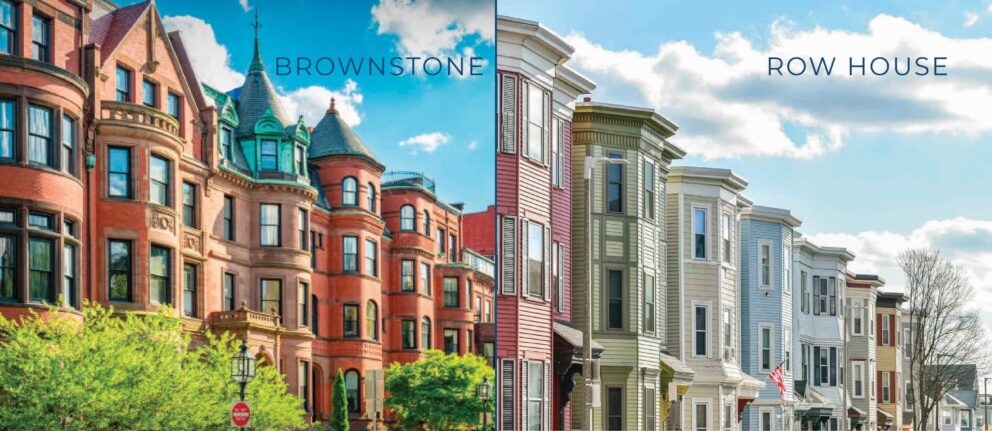Boston Brownstones are architectural gems with instant curb appeal that captivate residents and visitors alike with their timeless appeal. Constructed primarily in the 19th century, these rowhouses feature stunning facades and unique layouts that create a blend of elegance, character, and urban sophistication.
So wait, does Boston have brownstones or row houses?
While the terms “brownstone” and “row house” sometimes sound like they are used interchangeably, they are not always the same.
Brownstone:
A brownstone refers to a specific type of row house that is characterized by its facade material. True “Brownstones” are typically constructed using brown sandstone, which gives them their name. Red brick buildings are also lumped into the brownstone category even though they don’t generally appear to be brown. To confuse you a bit more, most of the true brownstone buildings are actually composed of brick and then have a brownstone veneer that is placed on the outside of the brick to give the building its final appeal.
These buildings gained popularity in the 19th century and are especially prominent in cities like Boston, New York, and Philadelphia. In any event, the brownstone category that we discuss daily includes any building that’s built of stone and has a brown, red, pink or even white color to it.
Row House:
On the other hand, a row house, or a row home, is a generic term used to describe a style of housing where several individual houses are joined together in a row. Row houses can be made of various materials, such as brick, stone, or wood. They share side walls with neighboring houses and often have a uniform appearance, creating a cohesive streetscape. They can also be referred to as “townhouses.”

In summary, all brownstones are row houses, but not all row houses are brownstones. And Boston Brownstones particularly exude a classic elegance that is hard to resist. Now that we’ve taken care of that, there are some key features that you may want to keep in mind while searching for your ideal brownstone:
The layouts that make up the building configuration can change:
While brownstones may look alike on the exterior, unit configurations can range from single family homes to a collection of condos. Often, in a six floor building you will either find a two triplex layout (where it would be split in half, with the top 3 floors being the upper unit and the bottom 3 being the lower unit) or a three duplex layout (where the square footages are split roughly evenly between the three units: Penthouse duplex, Parlor duplex and garden duplex).

As we like to say, “brownstones are like a box of chocolates,” no two buildings are exactly the same on the inside. Often you’ll see floor-though units mixed in with duplexes and triplexes or even unconventional, half-floor splits (Philly style!) mixed in that gives variety to these building make-up.

Width is everything! The width of each building varies with its unique architectural layout:
Typically spanning four to six stories, brownstone row houses feature a narrow, vertical design. However, not all buildings are created equally. Generally, we expect a Boston brownstone to range between 18’ to 25’ of width between the party walls it shares with its neighbors. Large floor plate brownstones can feel grand, while a more narrow product leverages intelligent use of space to allow for a cozy and intimate feel, even in the heart of a bustling city.
The availability and type of outdoor space that is offered may differ:
Despite their vertical layout, many Boston Brownstones boast outdoor spaces that offer a peaceful retreat in the heart of the city. From charming balconies and decks to lush courtyard gardens, these homes provide opportunities for residents to enjoy the outdoors and unwind in their own urban oasis. Penthouse units typically have roof decks while lower units will have a deck off the parlor level or a back patio off the garden level. This dichotomy always begs the question: do you prefer roof deck view or a luscious (and accessible!) garden patio?

And – don’t forget the range in stoop height!
The varying stoop heights in brownstones can be attributed to a combination of factors, including historical architectural styles, practicality, and accessibility. Some buyers prefer a grand entrance with a high stoop, while others may opt for a more intimate and accessible entrance with a lower stoop. The stoop height of a brownstone is often influenced by the desire to maintain visual harmony and consistency within a particular street or neighborhood, or it may reflect the architectural style of the building. For example, some earlier brownstones built in the Greek Revival style feature lower stoops, while later Victorian-era brownstones may have higher stoops.

Whether you’re a history enthusiast, an architecture lover, or simply seeking a distinctive and charming place to call home, Boston Brownstones hold an irresistible allure that continues to endure through the ages.
Want to know more?
We are here as a resource for all things Boston! When it comes to buying and selling property here, we have new insights to share with clients daily. Let us help you discover Boston and interpret it in new and enlightening ways.